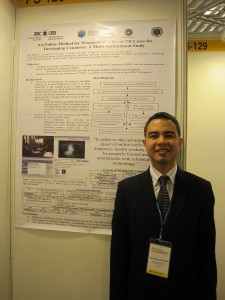Electronic TBDC presented in Hongkong
July 26, 2011 1:01 am | by Nimrod Firaza, MD | Posted in News
Just this July, UP Manila National Telehealth Center presented one of its research entitled “An Online Method for Diagnosis of Difficult TB Cases for Developing Countries: A Multi-Institutional Study” at the Asia-Pacific International Union Against Tuberculosis and Lung Diseases Asia-Pacific Conference (IUATLD) in Hongkong. The study was among the few innovations in TB management and diagnosis using information technology.
According to WHO Global Report in TB, Philippines rank nine among the 22 TB burden countries in the world. It is no wonder why in the South-East Asian region, the country remains to have the highest number of deaths in terms of rate of infectious diseases.

Dr. Paul Nimrod Firaza, electronic TBDC Project Manager of UP-Manila- National Telehealth Center with their Poster Presentation
In the Philippines, there are TB cases which involve patients whose x-ray results suggest that they are TB positive but their lab sputum results indicate “smear negative”. Smear negative means that TB bacteria is not present in the sputum sample. To be able to resolve cases like these, a TB Diagnostic Committee (TBDC) meet together regularly to evaluate said cases. However, most of the time, cases were not resolved due to geographical limitations of TBDC members. Most of the time, chest specialists are hardly reached in remote areas.
This problem spur telehealth solutions by establishing eTBDC (electronic TBDC). The eTBDC meets through convenient electronic means, which maximizes time, eliminates travel, and reduces related costs for health care delivery.
Findings of the research revealed that:
- diagnosis of difficult TB cases using electronic mail or free and open source software such as iPath is possible.
- accuracy of electronic diagnosis is comparable to face-to-face diagnosis.
- timeliness of diagnosis as an “expected benefit” is not appreciated unless health workers are adequately prepared.
In order to take advantage of the speed of online methods of diagnosis, health workers should be properly trained and comfortable with information technology. This underscores that users are primary in the development of technology for health care.